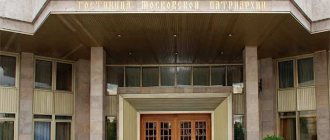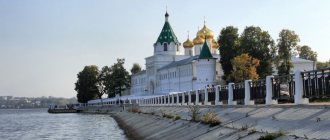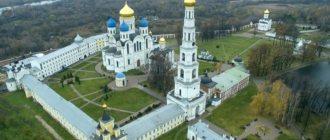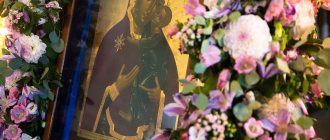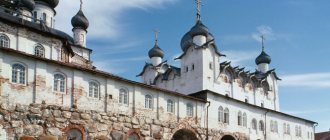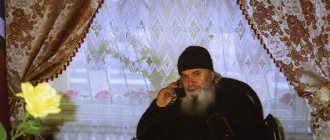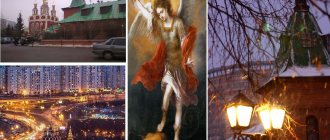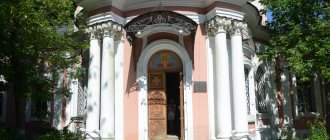One of the oldest monasteries in the capitals; the place where the Romanov tomb is located; the monastery, where for a long time there was a miraculous image of Christ the Savior, and now the icon “The Tsaritsa” is kept - all this is about Novospassky Monastery, one of the centers of spiritual life. Over the long centuries of its existence, the monastery was a place where monks lived and prayed, a prison, a fortress, and even a sobering-up station. Today the monastery is being revived, and a museum dedicated to the history of the monastery has been opened.
Visit and opening hours of the Novospassky Monastery
If you are planning to visit the Novospassky Monastery in Moscow, be sure to study the schedule of services: the monastery opens for visitors before the liturgy, and closes at the end of the evening service. In the monastery you can not only venerate the shrines or pray in front of the “Vsetsaritsa” icon, but also go on excursions. To do this, you should contact the excursion service in advance, which is open from 9.00 to 19.00 (7 days a week). You can also submit an application on the monastery website. The following excursions are conducted in the monastery:
- overview of architecture - an hour-long acquaintance with the monastery ensemble;
- sightseeing tour with a study of the architectural ensemble , a visit to the tomb of the Romanovs and the Transfiguration Church - acquaintance with fresco painting, the history of the monastery, a visit to the graves of the Romanovs;
- overview of the museum - acquaintance with the exhibition, photo gallery, rare exhibits;
- excursion along the walls - climbing the fortress walls of the monastery, walking through the garden of the monastery, visiting the tomb of the Romanovs.
Important! Since the monastery is active, do not forget about the monastic requirements for the appearance of visitors (women - in dresses, skirts, with closed arms and covered heads, without makeup; men - in trousers, covered shoulders, without a headdress). Photographing the brethren, as well as services in churches, is prohibited.
Schedule of services at the Novospassky Monastery
| Days of the week | Divine service | Start time |
| Monday Friday | Hours, Liturgy Vespers, Matins | 8.00 17.00 |
| Saturday | Hours, Liturgy All-night vigil | 8.00 17.00 |
| Sunday | Liturgy, prayer service Vespers, Matins | 7.00, 9.00 17.00 |
If you want to attend a service at the Novospassky Monastery, please note: during the period of Lent, the schedule of services changes.
The prayer service “To the Tsaritsa” in the Novospassky Monastery in Moscow takes place every day (except Sunday) after the end of the liturgy.
Patronal holidays
The main church patronal holiday - the Transfiguration of the Savior, is celebrated on August 19 according to the Gregorian calendar. The Orthodox Church honors it as one of the twelve holidays. August 31 – festive (praise) great service in veneration of the icon of the Mother of God, the Blessed Virgin Mary “The All-Tsaritsa” (Pantanassa). October 14 – Celebration of the Holy Protection of the Intercessor of our Mother of God. On the same day, a service is held in honor of the divine composer of prayers and psalms, Roman the Sweet Singer, the beloved heavenly patron of the Romanov dynasty. December 10 – festive service in veneration of the icon of the Mother of God “The Sign”. This is the main temple holiday of the Church of the Sign.
The Lord said that it is not the healthy, but the sick who need a doctor. Rarely does anyone come to the Novospassky Stauropegic Monastery out of idle curiosity. In Moscow there are many holy places of prayer where the soul is cleansed from sorrow and filled with grace.
People bring their illnesses, sorrows, a heavy burden of guilt and resentment here. And anyone who comes with sincere faith and a need for help will certainly receive it - in the form of relief, strengthening of mental strength, and often physical healing.
Article design: Vladimir the Great
History of the creation of the monastery
This monastery is one of the oldest Moscow monasteries and was founded by Prince Daniil . It was located in the place where the Danilov Monastery is located today. The Novospasskaya monastery existed there for only a few decades, after which it was moved to Borovitsky Hill, to the Church of the Transfiguration. In the middle of the 14th century, the stone Transfiguration Church, as well as other structures, were built here. At that time the monastery was simply called Spasskaya. During the period of John the Third, the Grand Duke's palace began to be actively disturbed, which is why the monastery was moved to Vasilievsky Camp. It was then that the monastery changed its name. At the end of the 15th century, the Transfiguration Church was founded and consecrated. During this period, the monastery became the site of the tombs of boyar families, including the Romanovs.
Later, the monastery began to perform another function - it was turned into a fortress that defended Moscow. Over time, the wooden wall surrounding the monastery was replaced with a stone one. In the middle of the 17th century, the image of the Savior not made by hands , but during the Soviet period it disappeared. At the same time, dungeons were built in the monastery, where heretics and criminals were kept. Starting from the reign of Peter I , the monastery gradually fell into disrepair - its property was plundered, some of the buildings burned down. However, during the period of the plague epidemic, it was the Novospassky Monastery that received Muscovites from different parts of the city. At the beginning of the 20th century , the monastery flourished again, becoming a center of religious education, but with the advent of Soviet power, the monastery was closed and turned into a concentration camp. Later, the necropolis of the monastery was destroyed, and an archive, a warehouse, and a sobering station were placed on the territory. Only in 1990 was the monastery returned to the believers, and over time the monastery was gradually restored.
Architectural and cultural monuments
Not all of the monastery’s churches have currently been restored; some of them are still under reconstruction. This is the Church of St. Sergius of Radonezh, which is built in a bell tower, St. Nicholas Church (originally a hospital).
- The central cathedral of the monastery is the Transfiguration Church , which was founded at the end of the 15th century, and the current building was erected in the middle of the 17th century. It is here that the icon “The Tsaritsa” is located; It was given to the Novospassky Monastery in Moscow two decades ago. The cathedral itself is unique with its fresco paintings, which were used to decorate it immediately after its construction. In addition to Orthodox subjects, the family tree of the Romanov family is depicted here, as well as Greek philosophers, symbolizing pagan wisdom. The tomb of the Romanovs is located in the basement of the cathedral.
- Church of the Intercession - erected in the second third of the 17th century; a refectory was attached to the temple. Since this church is located in a closed area of the monastery, it is not visible from the main square. It is here that the Sheremetyevs’ tomb is located .
- As for the church, located in the lower tier of the bell tower, this temple was destroyed during the French attack: one of the bells fell down, falling directly on the church.
- A memorial cross to Sergei Alexandrovich Romanov was also installed on the territory of the monastery . This is a copy of the cross that Vasnetsov designed (the original is in the Kremlin).
- Not far from the entrance to the monastery there is a small chapel erected on the burial site of the nun Dosithea. It is believed that this is what they began to call Princess Tarakanova after taking monastic vows.
- There is a museum at the monastery dedicated to the history of the monastery . The exhibitions demonstrate unique artifacts and church utensils of past centuries. There is an exhibition dedicated to Prince Sergei Alexandrovich.
Icon of the Mother of God “Vsetsaritsa”
The miraculous icon of the Mother of God, called “The All-Tsarina”
(in Greek - “Pantanassa”) is located on Holy Mount Athos in Greece in the cathedral church of the Vatopedi monastery, to the left of the royal gates. This icon, small in size, was painted in the 17th century and, according to legend, was the blessing of the famous Elder Joseph the Hesychast on Athos to his disciples.
The icon depicts the Most Pure Virgin in a scarlet robe, seated on the royal throne. In Her arms is the Infant God with a scroll in his left hand and with a blessing right hand. With her right hand, the Mother of God points to Her Royal Son as the Savior of all people. In the background are two angels who reverently overshadow the Most Pure Virgin with their wings.
According to an ancient monastic legend, one day a young man approached the icon and began to mutter something inaudibly. Suddenly the face of the Mother of God shone with a wondrous light, some invisible force threw the young man away, and he fell to the ground. Rising, he ran in fear to the elder monks and with tears in his eyes confessed to them that he had led an ungodly life, practiced witchcraft, and had come to the monastery to test the power of his magic on the holy icons. The miracle that happened at the icon of the Most Holy Theotokos forever turned the young man away from witchcraft, directed him to the path of repentance and returned him to the path of a pious life. The miraculous image of the Mother of God “The Queen of All” is revered both on Athos and far beyond its borders. The very name of the icon - All-Mistress, All-Mistress - speaks of its special, all-encompassing power. Having demonstrated its miraculous power for the first time against magical spells, the “Tsarina of All” also has the grace of healing patients with cancer - the most terrible disease of modern humanity (and the spread of passion for magic, witchcraft and the occult throughout the Christian world can be compared to the defeat of the human body by a malignant tumor).
On August 11, 1995, a copy of the miraculous icon “The Tsaritsa” arrived in Russia - at the Moscow Children’s Oncology Center on Kashirka. At prayer services to the Mother of God “The All-Tsaritsa,” sick children and their parents pray with the hope of the heavenly help of the Intercessor and Healer.
Shrines of the Novospassky Monastery
- The main shrine of the Novospassky Monastery in Moscow is the revered copy of the “Vsetsaritsa” icon (the icon itself is kept on Mount Athos, and the copy from it was made specifically for the Russian monastery). This image is miraculous, and people pray around it for the healing of cancer. The icon is regularly taken to the Moscow cancer center.
- The icon of the Savior not made by hands is another greatest shrine of the monastery. The miraculous face itself is lost, but a copy of it is kept in the monastery.
- Belt of John of Kronstadt - this shrine ended up in the monastery after a long stay in Bulgaria.
- Icon of Our Lady of Smolensk - this revered image of the monastery was given by the mother of Tsar Mikhail Fedorovich, who in monasticism bore the name Martha.
Also preserved in the monastery are reliquaries and icons with particles of the relics of saints.
Compound
The Novospassky Stavropegic Monastery has several official farmsteads.
Metochions of the Novospassky Monastery:
- Church of John the Baptist (location - the village of Sumarokovo, Ruzsky district, Moscow region);
- Church of the Archangel Michael (Milyukovo village, Pervomaisky rural district, Naro-Fominsk district, Moscow region);
- Church of the Icon of the Mother of God “Inexhaustible Chalice” (Durakovo village, Kaluga region).
Photo of Novospassky Monastery
- Behind the monastery walls there is a quiet atmosphere in which the soul seems to calm down.
- The panorama of the monastery amazes with its architectural perfection.
- Memorial cross to Sergei Aleksandrovich Romanov, the author of which was Vasnetsov.
- The Transfiguration Cathedral is one of the symbols not only of the monastery, but of the entire capital.
- Princess Tarakanova is supposedly buried under a small modest chapel.
- The majestic bell tower of the monastery is visible from afar.

